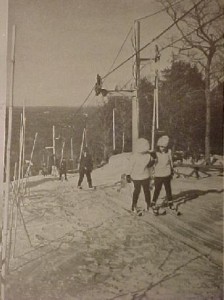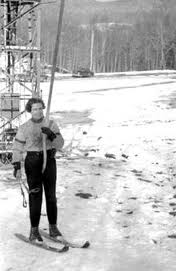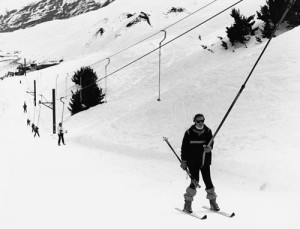
- Riding a T-bar
The first T-bar in the U.S. was at Pico and began operation in January 1941. At the time it was the highest capacity lift in North America! Brad and Janet Mead, founders of Pico and parents of Olympic Gold Medalist Andrea Mead Lawrence, brought Ernest Constam from Switzerland to design and build the T-bar.
No one got the entire answer correct this past week, but without resorting to Google, Parker Riehle did know the first T-bar was at Pico. Could that be the Parker Riehle from the Vermont Ski Area Association?
So are you ready for your first T-bar ride?
OK. This is much easier than a rope tow. The lift operator will hand you the bar, you position the cross bar just below your butt and let it pull you up the mountain. Just remember that you don’t sit on the cross bar, you let it pull you. So you’re ready, put your poles in your outside hand, step out, get the bar from the lift operator, ….. Great you’ve got it!
Here, let me help you get your skis back on. I did mention about not sitting on the bar, didn’t I? Let’s try again and this time I’ll ride up with you.
See that wasn’t bad. You got it on the second try! Yeah, I don’t know why they don’t have these on the beginner slopes either.
We’re getting near the top and I’ll get the bar. That means you just ski away from the lift and I will take care of releasing the T-bar. Here we are so get off. Now….Now….NOW!
Once I get my skis back on I’ll help you with yours.

- Riding a T-bar
Also there was still the matter of “the track”. Ruts and bumps would develop in the track similar to a rope tow, but now a mistake by one rider could take both riders down. It’s unclear how many relationships ended in two piles of equipment lying beside a T-bar track.
One new problem created by T-bars occurred when there was a disparity in height between the two riders. So if you wanted to ride up with your five year old, the bar ended up behind your knees leading to an uncomfortable and off-balance ride. The old T-bar on the Easy Street side of Little Spruce was a great example of this. Much like today that slope was home to many skiing munchkins. Instructors were looking for adults to help get them up the hill. More than once I rode up with the bar just above my boot backs while my pint-sized partner tried to jump every bump in the track!

- Riding a Poma Lift
Unlike T-bars, Poma Lifts (named for founder Jean Pomagalski) had individual pomas or platters that detached from the cable and only transported one skier at a time. The lift attendant handed you a poma which you placed between your legs and then the attendant would attach it to the cable. If you got a poma with a good spring, it cushioned the sudden acceleration from zero to lift speed. But with older pomas there could be quite a jerk once the spring extended. Kids actually loved this feature and would almost sit on the poma awaiting the jerk that would send them airborne up the lift line. This practice usually resulted in a mogul forming in the track at the load point causing problems for less experienced riders. The Poma lift at Burke always had one of these and probably still does!

- Riding a Poma Lift
“Poma lifts are made in France, makes the girls come back for one more chance.” I believe this was a line from a poem/song that included rhymes about other ski lifts as well, but I have been unable to locate the source. Don’t ask why this is the one line I remember!
Anyway, for years the French put Poma lifts everywhere! They had Pomas that went around corners; they even had Pomas where at some points you went downhill! That latter case was a little disconcerting since you actually got ahead of the lift and when the lift finally caught up, the loading “jerk” was repeated.
As entertaining as surface lifts were, skiing’s popularity grew with the introduction of the chairlift. So this week’s trivia question is: Where was the first chairlift in the world and when did it begin operation?
Tis the season to be shopping and if you have a RetroSki-er on your list, consider a visit to the Vermont Ski Museum either in person or online (www.vermontskimuseum.org). They have quite a selection including items that use vintage Stowe images from the Stafford collection. Bob Stafford was kind enough to let me use some of these for my blog.

Recent Comments